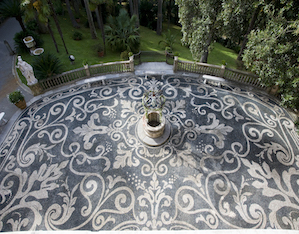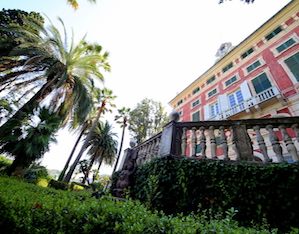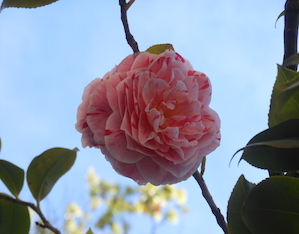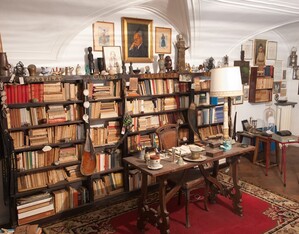Created in its present form between the 19th and 20th centuries, this garden owes its beauty to the coexistence of a formal layout and a wooded area, not to mention splendid views out over the Gulf of Tigullio.
With its square plan, the Villa follows the typical template of architect Galeazzo Alessi’s 16th-century villas. In 1664, the Chiavari family took over the property from the Durazzo family, and from 1678 undertook radical renovation. In 1821, the Centurione family became owners. They made several changes to the complex, replacing the chestnut wood with a “romantic” park, embellishing the terraces with marble busts of illustrious Genoans, and planting trees including camphor, magnolias and palms. Giovanni Franceschetti gave the entire complex a new look, covering the terrace overlooking the sea in beautiful floral and arabesque mosaics. As part of the 1892 “Colombus Celebrations”, the villa was converted into a hotel frequented by leading figures from the international aristocracy, including Queen Margaret of Savoy. In 1919, the property was acquired by Alfredo Chierichetti, who oversaw a major transformation of the park, including enrichment of the wood with exotic new species and new paths. In 1973, the City of Santa Margherita purchased the Villa and opened it to the public. The citrus grove on the terrace looking out to sea is the oldest part of the garden; the 19th-century formal garden is divided into geometrical parterres bordered by boxwood hedges containing groups of roses, camellias and specimens of Cycas revoluta; we owe the arrangement of the forest, sloping down along the hill, to the 19th and 20th centuries. Concealed amongst the greenery, the Centurione Princes’ diminuitive “secret garden” was recently restored. A series of paths connects the Villa to the Capuchin convent, the church of San Giacomo and surrounding villages, making the garden the central hub of the local territorial system.
Highlights

The “Risseu” Terrace
The Villa’s rear terrace is decorated with a mosaic of floral motifs crafted in the 1920s using black and white pebbles, designed by Giovanni Franceschetti. It is a revival of “risseu”, a typical flooring technique that was widely adopted throughout the arc of Liguria from the 16th century onwards.

The Villa
The residence was built in the early 17th century. It was enlarged by the Durazzo family from 1678 onwards. The apartments on the main floor, with their richly-furnished rooms and valuable picture gallery featuring Genoese School works from the 17th to 18th centuries, is open to visitors.

Botanical Variety
The park contains more than ninety different species of plants, laid out thematically or in groups, including centuries-old camphor trees, cypresses and holm oaks; the camelia bed, which was once far more extensive, features heirloom and valuable specimens. Starting in 1919, over a hundred different palm varieties have been planted here.

Art Collection
The Villa is home to the “Bellometti Collection”, featuring works of modern art, ceramics and chinoiserie, as well as a reconstruction of the study used by local man Vittorio Giovanni Rossi, a journalist, special correspondent and writer on travel and the sea.
 Villa Durazzo Centurione
Contacts
Villa Durazzo Centurione
Contacts
Contacts
Telephone:+39 0185 472637
+39 0185 472637
Address
Via S. Francesco D'Assisi, 3
16038, Santa Margherita Ligure (GE)
 Villa Durazzo Centurione
Opening times and prices
Villa Durazzo Centurione
Opening times and prices
Opening hours
Villa
- Summer timetable: every day 9.30 a.m. – 1 p.m. and 2 p.m. – 6 p.m.
- Winter timetable: every day 9.30 a.m. – 1 p.m. and 2 p.m. – 5 p.m.
Park
- Summer timetable: every day 9 a.m. – 7 p.m.
- Winter timetable: every day 9 a.m. – 5 p.m.
Pricing
Villa
- Full price € 5,50
- FAI and Touring Club members € 4,00
- Children 8-14 years € 3,00
Park
- Free entrance
 Villa Durazzo Centurione
How to get there
Villa Durazzo Centurione
How to get there
Address
Via S. Francesco D'Assisi, 3
16038, Santa Margherita Ligure (GE)
Latitude: 44.3334085
Longitude: 9.2079488
How to arrive by road
It can be reached by car, exiting at the Rapallo motorway tollgate (A12 motorway), continuing to Santa Margherita Ligure (about 5 km), following the road signs.
Additional directions
Villa Durazzo is about 30 Km from the international airport of Genoa and just under 1 Km from the railway station of Santa Margherita Ligure.
 Villa Durazzo Centurione
Services/Accessibility
Villa Durazzo Centurione
Services/Accessibility
Services
At about 100 meters from the entrance of Via San Francesco d'Assisi there is the city parking/silos "Autopark Riviera" for a fee, which can accommodate up to 200 vehicles.
Groups can choose from various types of guided tours lasting up to two hours, including: a tour of the apartments of the Marquis Durazzo and the Princes Centurione, a visit to the park surrounding Villa Durazzo with an explanation of the various areas: citrus grove, English woodland, secret garden, Italian garden and a visit to the ancient "Paths of San Giacomo" that run along the park of the villa up to the castle. The proposals for visits accompany the visitor to discover the beauty of the villa and its park and constitute, in addition to an opportunity for cultural study, also an opportunity for recreation and relaxation in one of the most beautiful spots of the Tigullio. The visits are aimed at all types of public and are always flexible and "modular" according to the needs of groups. At the end of the visit you can also have lunch, an aperitif or a special tasting of typical Ligurian products.
- The educational activities take place for a maximum of 25 children and cost € 4.00 per pupil. Reservations are required. For information: +39 0185 472637 or [email protected]
- For kindergarten and primary school classes there are several educational workshops available: "Federico the mouse in the park of Villa Durazzo", "A day in the villa of the Prince" and "Discovering the wonders of the park".
- The educational offer also includes a guided tour for the secondary school "The mysteries of the villa".
- The workshops aim to introduce children to the main historical, artistic and naturalistic aspects of Villa Durazzo and the surrounding park through an interactive narrative that stimulates their curiosity and desire for discovery.
In the park there is the Coffee House of Villa San Giacomo, an evocative refreshment point, which with its indoor and outdoor spaces offers guests moments of relaxation, surrounded by greenery and overlooking the beautiful Gulf of S. Margherita Ligure.
 Villa Durazzo Centurione
Private events
Villa Durazzo Centurione
Private events
The Secretariat of Villa Durazzo is the reference point for any initiative or event to be organized within the villa. Upon request, provides guidance and referrals for qualified service providers to support.
Contacts: Tel. +39 0185 472637 – Fax 3346779998
 Villa Durazzo Centurione
Itineraries
Villa Durazzo Centurione
Itineraries
You could find the garden in these itineraries
 Favorite saving result
Favorite saving result
 Warning!
Warning!
You've have to sign up or sign in to add this element to your favorites.
